by Rajan P. Parrikar
First published on SAWF on June 26, 2000

Rajan P. Parrikar (Boulder, Colorado, 1991)
Namashkar.
With the heights of the Bhairav terrain scaled, our onward peregrinations now bring into view the most profound, finespun idea in melodic music: raganga Todi. The encomia lavished earlier on the Bhairav dynasty carry over pari passu to the Todi clan. As with Bhairav, Todi denotes a that, a raga, and a raganga. All three merge seamlessly in Raga Todi. From ecstasy to frolic to pathos to bathos to melancholy—every conceivable human emotion has been refracted through the prism of Todi. To let Todi resonate in the corridors of the mind is to experience the rarefied delights of intellectual and emotional sport. This raganga is so elemental that it is not far-fetched to speak of a “Todi gene” in the musico-cultural DNA of India.
Let M = shuddha madhyam and m = teevra madhyam.
Raganga Todi and Raga Todi
We begin with an inquiry into raganga Todi. The scale of the Todi that corresponds to the 45th Carnatic melakarta Shubhapantuvarali: S r g m P d N. The kernel of raganga Todi resides in the following tonal motif:
S, r, r<–>g, g, r, S
The uccharana (intonation and punctuation) of the subtle interplay between r and g is critical; without it, Todi is dead on arrival. These two swaras manifest themselves as a seamless, symbiotic relationship within the melodic framework. The movement r–>g, with a nyasa on the gandhar, is vital, while the reverse g–>r lingers on the rishab before dissolving on S. The fluid r<–>g transition unfolds gradually, with one swara melting into the other, evoking the ineffable “Todi effect”—a palpable unease that is at once captivating.

The Todi anga and its uccharana are elegantly elucidated by Pandit Ramashreya Jha “Ramrang.”
Raga Todi is a quintessential raganga raga, serving as the primary custodian of the raganga genetic material. It is also known as Miyan ki Todi, Shuddha Todi, and Darbari Todi.
The lakshanas of Raga Todi are now outlined:
S, r<–>g, g r, S
This phrase encapsulates the raganga signature described earlier.
g m d, N d, d m g r, g, r S
This movement highlights the dominance of the dhaivat (nyasa bahutva) and the omission (langhan alpatva) of the pancham in certain contexts.
S r g m P, P m d, d N d, P, dmgr, g
Here, the pancham acts as a nyasa swara. The treatment of P varies depending on the performer’s lineage and aesthetic inclination. While some employ it liberally, others reserve it for repose in avarohi movements, using it to release tension after explorations in the uttaranga. The madhyam and nishad play supporting roles, with the nishad occasionally elongated (deergha) in the lower octave or omitted (langhan alpatva) when ascending to the higher octave: d, d S”.
In Gurjari Todi, the pancham is entirely omitted, though its melodic essence adheres to the Todi archetype. Some practitioners accentuate the role of the komal rishab to further distinguish it.
This completes our prelude. We have illuminated the core features of Todi while omitting ancillary details that are best grasped through performance and listening. The accompanying audio selections will provide a more comprehensive understanding for the discerning rasika.
We kick off with this memorable clip where an animated Pandit Ramashreya Jha “Ramrang” recounts his takedown of M.R. Gautam of BHU, the bone of contention being the lakshanas of Raga Gurjari Todi.
Our user-friendly suite of ‘light’ pieces follows. They are called ‘light’ but there is nothing light about them. M.S. Subbulakshmi‘s chanting of Adi Shankara’s stotras tuned by Kadayanallur Venkataraman sets the ball rolling.
The shabads in the Gurbani show an affinity for Todi. This one in the voices of Ajit Kaur and Co is tuned by K.S. Narula: mango dana thakura nama.
Basavraj Rajguru‘s self-tuned rendition of Basavanna’s vacana: madi madi.
Lata Mangeshkar was born with extraordinary musical gifts. Meerabai’s bhajan is tuned by Hridaynath Mangeshkar: nanda nandana.
Tukaram’s abhanga is set to music by Shrinivas Khale. Lata Mangeshkar: aga karunakara.
We unveil the filmi tableau.
BAIJU BAWRA (1953, Naushad, Shakeel Badayuni) carried a Mohammad Rafi number: insan bano.
Sardul Kwatra, a resident of the Bay Area of San Francisco these days, is the tunesmith for this Lata muffin from PILPILI SAHAB (1954): jaba tum hi hame.
This Roshan and Sahir Ludhianvi masterpiece was rolled out for TAJMAHAL (1963), again with the ubiquitous Lata: khuda-e-bartar.
Manna Dey, Laxmikant-Pyarelal and Bharat Vyas pool in for this SANT GYANESHWAR (1964) number: jago re prabhat aaya.
Another baton awash in classical music was Vasant Desai. From AASHIRWAD (1968), Gulzar‘s lyrics are delivered by Lata: ek tha bachpan.
The 1971 musical bonanza AMAR PREM had some classics, among them this quasi-Todi creation of R.D. Burman. The effortless forays in and out of Todi are ingeniously conceived. Lata Mangeshkar: raina beeti jaye.
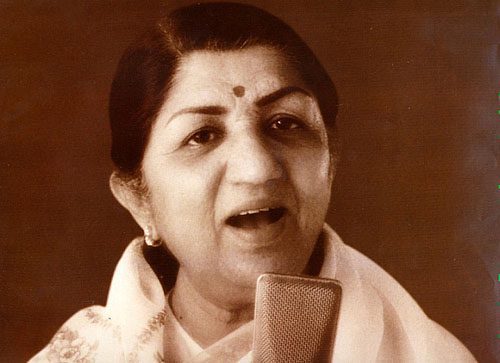
Lata Mangeshkar
(From I&B Calendar 2005)
When Lata refused to sing for MEERA (1979) several composers backed off and Gulzar found himself knocking on Ravi Shankar‘s door. The maestro pulled G’s chestnuts out of the fire in a trice. The haunting orchestral prelude is followed by Vani Jairam: eri main to prem diwani.
We now present a snatch of a rare taleem session by Pandit Kishore Kumar of Khandwa gharana in R.D. Burman‘s studio.
Lata and Hridaynath Mangeshkar divert the well-known Todi bandish of “Sadarang” towards Gurjari in LEKIN (1991): ja re ja pathikava.
A jaunt down Noorjahan‘s nostalgic alley. The composer is Khurshid Anwar: jis din se piya.
Jigar Moradabadi‘s ghazal is tuned by Taj Ahmad Khan and rendered by Mohammad Rafi: saqi ki har nigah pe.
We conclude the ‘light’ round with this hideous bout of hideous giggling. Indian women, please don’t giggle like this.
Sir Vish Krishnan‘s counsel and assistance in the above compilation are gratefully appreciated.
For the classical session, we have lined up a dazzling array of Todi samplers.
The deep sonorous tones of Zia Mohiuddin Dagar‘s rudra beena summon a magisterial ambience. “Shuddha Todi” is his brand name for the well-worn Hindustani Todi (Shuddha Todi is an entirely different construct in the Carnatic paddhati). This clip resoundingly (pun intended) reveals Todi for the extraordinary aubade that it is.
Asad Ali Khan, another distinguished exponent of the rudra beena.
The dhrupadiyas revel in Todi. Tansen Pande (1908-1963), son of Alla Bande Khan (patriarch of the Dagar family), started out as Hussainuddin Dagar but in the 1940s returned to the dharma of his forebears (the Dagars were Pandes to begin with).
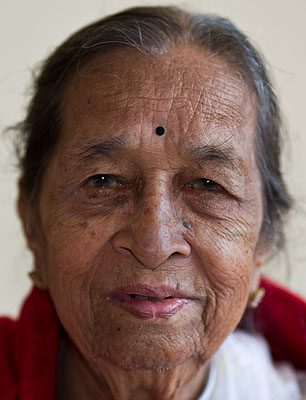
Gangubai Hangal
(© Rajan P. Parrikar)
The Darbhanga region of Bihar was once a hive of dhrupad culture. Among its surviving representatives, Ram Chatur Mallick.
Another Bihari, also from Darbhanga, is Ramashreya Jha “Ramrang,” the preeminent Hindustani vaggeyakara and vidwan. Jha-sahab sketches the famous vilambit khayal of “Sadarang” which locates its sam located on the pancham: daiyya bata doobara bhayi.
Jha-sahab’s lament about the violence done to the lyrics gains in credibility as Bhimsen Joshi is found in flagrante delicto, amusingly enough with the same bandish. Bhimsen, of course, has mastered Todi like few others have.
Gangubai Hangal: bajo re.
I read a posting on rec.music.indian.classical (RMIC) that referred to a visiting Indian musician as a Gwalior “stalwart.” I am in agreement only 50% (the part about “wart”). For 100% agreement we must look elsewhere, to Krishnarao Shankar Pandit. The bandish is a Gwalior staple: lala manavana.
Speaking of Gwalior stalwarts, D.V. Paluskar sings the vilambit bandish of “Manrang”: – aba more Rama – and tops it off with a sparkling cheez.
Kishori Amonkar‘s recent release is a modern classic.
Another great exponent from the Atrauli-Jaipur camp presents an old khayal of “Sadarang.” Mallikarjun Mansur: bajo re.
Jha-sahab has composed a most beautiful bandish to Goddess Saraswati. We hear it from Nachiketa Sharma.
Jha-sahab himself quickly runs through his busy cheez in Gurjari Todi.
Ramkrishnabuwa Vaze was trained by Nissar Hussain Khan of Gwalior (not to be confused with the contemporary Rampur vocalist) and Shankarrao Pandit (KRSP’s father). He was a perpetual seeker and travelled all over India in search of music and compositions. Of mercurial temperament, stories of Vazebuwa’s eccentricities are legion. The recording presented is a recent release and although he was wary of putting pen to paper the bandish does find a spot in his published work: masalata puccha diya tusa.
The Atrauli-Jaipur statement by its most distinguished representative, Kesarbai Kerkar of Goa.
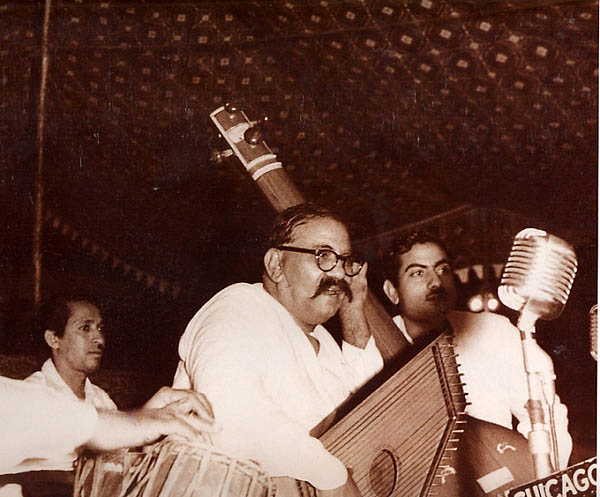
Bade Ghulam Ali Khan, flanked by Munawar Ali
(From I&B Calendar 2005)
Bade Ghulam Ali Khan‘s recent issue of Allah jane maula jane does scant justice to him. This blitzkrieg in Gurjari Todi taped in healthier times is more representative of his peremptory gayaki: bhor bhayi.
A concert recording of Jitendra Abhisheki amplifies on a Gurjari cheez of “Manrang”: chalo sakhi sautana ke ghara.
We now reach for the instrumental bin. This is an old recording of Habib Ali Khan on vichitra veena.
In the realm of swara Bismillah Khan has no equal among instrumentalists. He slips into the Todi groove in three shakes of a lamb’s tail.
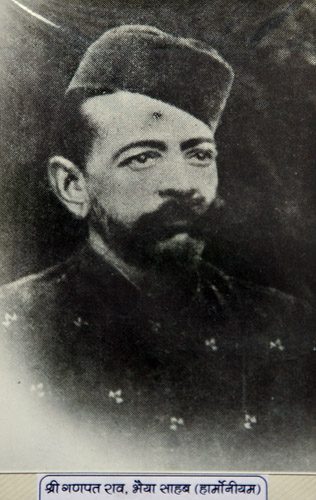
Bhaiya Ganpatrao (courtesy Kashi Sangeet Samaj)
Incidently, Bismillah’s tap-tap technique in the final druta moments is, by his own admission, an adaptation from the harmonium whiz of an earlier era, Bhaiyya Ganpatrao of Gwalior.
Ali Akbar Khan serves up a dhamar supported by Mahapurush Mishra on tabla.
Back into the vocal pool, Omkarnath Thakur‘s histrionics come to flower in this well-known cheez: garava maisana lagi.
Abdul Karim Khan negotiates a composition of “Saraspiya”: beguna guna ga’iye.
The pupil Sawai Gandharva stays true to his guru’s swara-lagav: samajha mana Gorakha-dhandha.
We conclude the Kirana carnival with Hirabai Barodekar: kakariya jina maro.
Azmat Hussain Khan‘s background spanned both the Atrauli and Agra styles. He was an influential teacher and composer (colophon “Dilrang”). This is from an old recording at the Goa Kala Academy.
Agra’s Latafat Hussain Khan has the final word.
That brings us to the end of the Todi montage. A few well-known bandishes have escaped our dragnet, for instance, Tanras Khan‘s aba mori naiyya para karo re.
Next, we address several important derivates of Todi.
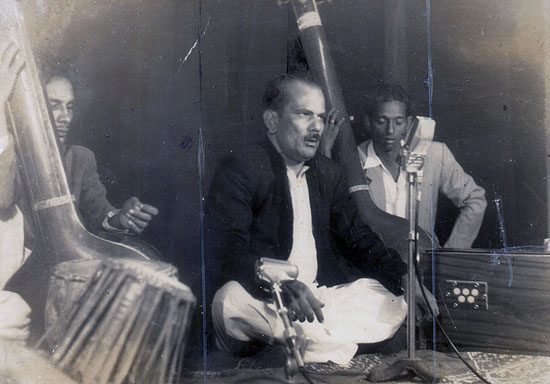
Azmat Hussain Khan
Raga Bhoopala or Bhoopal Todi
The chief pentatonic Todi derivate, (Chhaya Todi – S r g m d – is rarely performed), Bhoopala is scalewise identical to its Carnatic counterpart: S r g P d. It must be underscored that mere scale does not a raga make. Far too may people these days fail to appreciate this elementary point.
M.S. Subbalakshmi‘s chant of Adi Shankara’s stotras.
Pandit Ramashreya Jha “Ramrang”: lage nahin re manuva.
Basavraj Rajguru wields a composition of “Gunidas”: naiyya utari par.
Final item in the Bhoopala suite: Ali Akbar Khan‘s gat set to Upatala of 8.5 matras.
Raga Saheli Todi
This raga conceived by Kumar Gandharva extends Bhoopal Todi by stringing komal nishad in vakra prayogas. An avirbhava of Bilaskhani Todi occasionally obtains.
Raga Bilaskhani Todi
Bilaskhani Todi is among the very great ragas and to scrape its acquaintance is to come touchably close to the sublime in music. It is profoundly original in conception, a musical minefield difficult to tread. Its complexity is masked by the ready emotional purchase offered to the rasika. It is a meend-pradhana raga with a fund of nuance scarcely amenable to the written word. We shall nevertheless try to convey the vitals.
The basic aroha-avarohana set may be stated as:
S r g P d S”::S”, r” n d, P, d n d M g, r g r S
This does very little to illuminate the raga lakshanas. Although the swaras of Bilaskhani are drawn from the Bhairavi that its structure is wholly defined and fortified by raganga Todi. Care must be observed to stay clear of Bhairavi’s demesne for any misstep will spell instant ruin for Bilaskhani.
The madhyam is acknowledged gingerly in ascent, and the tonal thought typically prefaced or concluded by emphasizing the Todi raganga in the poorvanga regime. This manouvre dispels any incipient Bhairavi aspirations. An M-laden prayoga is illustrated:
S, r n’ S r g, (g)r g M, M, (g)r g, r, S
Note the avarohi langhan of the shadaj.
The pancham is an important nyasa-sthana for the swara traffic in both directions. The madhyam is necessarily cold-shouldered in ascent en route to pancham and beyond, viz., S r g P or S r g P d, but is deployed in avarohi prayogas, where it is the pancham‘s turn to be spurned: d n d M g r, g.
This skipping (langhan) of arohi madhyam and avarohi pancham is the Achilles heel of Bilaskhani, violation of which injures the raga. The komal nishad is used as either a cushion by the dhaivat (d n d M) or as an anuvadi swara (r n’ S r g; r” n d M g r S). The uccharana of the meends are critical, the lifeblood of Bilaskhani.
This clip from LEKIN begins with Satyasheel Deshpande‘s recitation of the definitive khayal, neeke ghungariya, attributed to “Sadarang.” Asha Bhonsle then assumes charge and sings jhoothe naina, a composition inspired by S.N. Ratanjankar (see the next item).
Malini Rajurkar renders Ratanjankar‘s beautiful bandish. Alas, she is in such a tearing hurry that the delicate flavours of verse and melody are smothered.
Jha-sahab‘s double header includes his delightful druta, Jagadambika Ambika.
Ramrang, vilambit.
Ramrang, druta.
One of Jitendra Abhisheki‘s earliest recordings featured a memorable innings in Bilaskhani with a bandish composed by C.R. Vyas: taja re abhimana.
An ennobling 1960s Delhi mehfil of Amir Khan marks our Bilaskhani finale.
Raga Asavari Todi
This raga is also known as Komal Rishab Asavari and rightly belongs to a discussion of Asavari anga ragas (see Asavari & Associates). Although the Asavari anga serves as its base, there is a soupçon of Todi. Its set of notes is identical to Bilaskhani Todi but the raga-charitra follows the Asavari dicta. A few schools use both the rishabs (eg. Allauddin Khan of Maihar). Then there’s the allied Raga Gandhari to watch out for. This unpublished Amir Khan excerpt is food for the soul.
Raga Bahaduri Todi
This highly vakra raga employs both rishabs, komal gandhar, komal dhaivat, and shuddha madhyam. The disparate constituents are tied together by special sancharis and the intonation is mediated by meends. The first theme is contributed by raganga Todi (r g r S), the other supplied by Raga Desi.
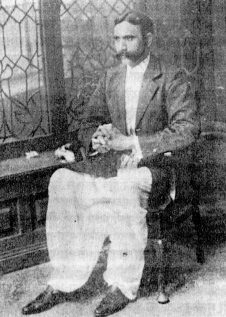
Alladiya Khan
This is an exceedingly beautiful raga, known for its aesthetic unity inspite of its convoluted structure. There are two principal versions of Bahaduri Todi of which one is discussed here. This raga bears no kinship to the Carnatic Bahudari.
The preferred strategy draws on Desi for the arohi development in the poorvanga. The eventual termination of the melodic sorties draws on the Todi anga.
Let us consider the lakshanas.
S R g (S)R g
The arohi shuddha rishab is equipped in special fashion; notice the grace of shadaj in the second instance.
The gandhar is informed by both Desi and Todi. The madhyam is approached from gandhar and dwelt upon; it is skipped (langhan) en route to pancham. The komal dhaivat is caressed with a touch of komal nishad. These ploys are summarized as follows:
S, R n’ S R G (S)R g – (Desi)
g R g M – (nyasa on madhyam, special prayoga)
(M)g (M)g P – (approach to pancham)
P, (n)d (n)d – (komal dhaivat caressed with n)
(n)d (n)d S” – (approach to the tar shaaaj, nishad skipped)
r” n d M – (special meend)
P (g)R g – (Desi)
RgM, M g r g, r, S – (conclusion with raganga Todi).
We experience the raga through the eyes of two great musicians, each a master of his chosen metier. One is a peerless vidwan and vaggeyakara, the other a performer the likes of whom don’t come by often.
Pandit Ramashreya Jha “Ramrang” quickly lays out the lakshanas.
Ramrang, vilambit.
Ramrang, druta.
Mallikarjun Mansur‘s tour de force in this 1968 recording when he was at the peak of his powers is a spectacle fit for the Gods. Observe the special nature of tans deployed and the breathtaking dexterity with which he negotiates the tightropes snaking through. The tans are distinguished for their double, triple, and quadruple note clusters, gamakas, and safa’i in execution. This is directed, controlled virtuosity at its most sublime. At the end of it all the raga emerges effulgent.
Raga Ahiri Todi
This raga draws on raganga Todi in its poorvanga and Ahiri in its uttaranga. The swaric material is drawn from the 10th Carnatic melakarta Natakapriya: S r g M P D n.
A little consideration shows that this scale is generated by an appropriate murchhana/graha bhedam on Charukeshi (see On Raga Charukeshi).
Two outstanding compositions of Jha-sahab are offered.
Jha, vilambit.
Jha, druta.
Nikhil Banerjee adopts the name “Aahiri” for his presentation.
Obiter dicta: A different version of Ahiri Todi found in the literature has now gone out of fashion. Also, Ravi Shankar has eliminated the pancham from the parent scale to extract a fetching melody he calls Parmeshwari.
Raga Salagavarali
S.N. Ratanjankar conceived of this raga. It draws its swaric material from the 46th Carnatic melakarta Shadvidhmargini: S r g m P D n.
The madhyam is eliminated to yield the following contour:
S r g P D n D S”::S” n D P g (P)r g, r, S
The raga has been brilliantly exploited by Jeetendra Abisheki in a celebrated natyageeta. Watch out for the injection of a vivadi dosha via teevra madhyam: gheyi chhanda makarand.
Ratanjankar‘s original composition is popular and widely performed. K.G. Ginde: sumara saheb sultana.
Raga Mangal Gujari
A relatively new entrant into the Hindustani system, its swaras emerge from the 44th Carnatic melakarta Bhavapriya: S r g m P d n. The Hindustani raga employing this sampoorna scale set goes by the name Adarangi Todi. In Mangal Gujari the pancham is varjit, rendering its scale identical to the Carnatic Bhavani (the Hindustani Raga Bhavani is a very different horse, a chatuswara raga of the Bilawal that).
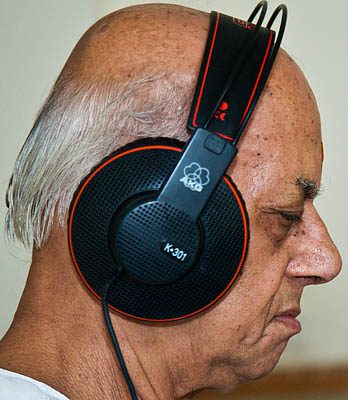
Ramashreya Jha “Ramrang”
(© Rajan P. Parrikar)
Mangal Gujari resembles Gurjari Todi in its mannerisms with the proviso that its nishad is komal. Ragas employing the komal nishad-teevra madhyam combine are scarce in the Hindustani system. Madhukauns is the homespun example that comes to mind. The rest of the m-n-laden ragas currently in the Hindustani employ – Saraswati, Vachaspati, Shanmukhapriya, Hemavati – are borrowed from the Carnatic domain.
Mangal Gujari’s profile assumes the following form:
S r g m d n S”::S n d m g, r g, r, S
It is seen at once that scalewise the following equation holds true:
Gurjari Todi : Miyan ki Todi :: Mangal Gujari : Adarangi Todi
The swara track in Mangal Gujari is known to present some discomfort to the unaccustomed Hindustani mind, particularly around the komal nishad area.
Ramashreya Jha “Ramrang” burst into Mangal Gujari one afternoon after lunch quite unexpectedly. Fortunately I had the recorder at the ready.
Raga Khat Todi
This uncommon prakar containing both madhyams is mostly sung by Atrauli-Jaipur and Agra musicians. In the main body of Todi a small phrase of Khat is introduced. Two Atrauli-Jaipur flavours, differing in the type of the leading Khat phrase employed, are offered.
Anandrao Limaye uses the gMPdn P cluster.
Whereas Mallikarjun Mansur co-opts R M R P.
Raga Jaunpuri Todi
An admixture of both Jaunpuri and Todi, effortlessly assayed by Mallikarjun Mansur.
Raga Laxmi Todi
This traditional Todi prakar reveals chhayas of Gaud, Asavari, Kafi within the Todi framework.
K.G. Ginde is ill at ease with this dhamar composition of Ratanjankar.
Jha-sahab‘s enchanting bandish scythes to the raga core: aaja hamari.
Raga Mangal Todi
The insertion of a special tonal phrase containing shuddha madhyam into the Todi stream is the main idea in this aprachalita prakar.
Ram Marathe elaborates.
Raga Hussaini Todi
Elements of Hussaini Kanada and Asavari are woven into the Todi fabric in this aprachalita prakar. These arcane varieties are ‘small’ ragas (“asthai-antare ke raga“). Jha-sahab likens them to chutney in the course of a main meal: tero samana Sa’i.
The Agra-Atrauli musicians purvey a completely different version of Hussaini Todi, one that has no Todi anga whatsoever in it. Kishori Amonkar: niranjana ki jai.
Raga Abheri Todi
Another obscure variant in which strands of Asavari and Khamaj are tied to the Todi anga.
Ramashreya Jha “Ramrang”: gunijana ga’iye baja’iye.
Raga Viyogavarali
This baby of S.N. Ratanjankar belongs to the 9th Carnatic melakarta Dhenuka: S r g M P d N. The raga is attained to by eliminating pancham and introducing Todi anga via the r-g coupling. The following tonal profile results:
S r M d N S”::S” N d M, r g, r, S
The raga is attractive and deserves wider popularity. Ratanjankar’s composition appropriately refers to viyoga. K.G. Ginde: binati yahi na jaiyyo Mathura.
Raga Suha Todi
This jod-raga with Suha peppered with Todi anga is peddled by Ali Akbar.
Raga Bairagi Todi
The audav-jati raga was introduced by Ravi Shankar. To get its scale, replace the madhyam in Bairagi with komal gandhar: S r g P n.
Ravi Shankar‘s gat is set to Sade Gyarah tala (11.5 beats).
Jha-sahab has developed another version of Bairagi Todi where a dash of Todi anga is injected into the Bairagi body.
Raga Niranjani Todi
In this creation of l’enfant terrible Kishori Amonkar, elements of Ahir Bhairav, Bairagi and a Bhinna Shadaj-esque nishad are observed. I don’t have the gal’s recording yet so we will have to do make do with her pupil Raghunandan Panshikar.
Raga Lachari Todi
Although this is acknowledged as a traditional Todi prakar, there is no hide nor hair of Todi in the version rendered by V.R. Athavale. The development is grounded in Asavari.
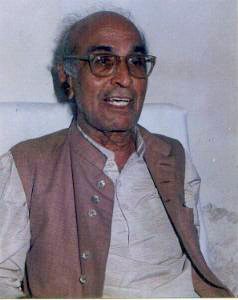
V.R. Athavale
On the other hand, while Mallikarjun Mansur‘s tonal brief takes Asavari for its base, a soupçon of Todi-anga is injected via komal rishab.
Raga Jaiwanti Todi
Jaiwanti Todi is a conception of Maharana Jaiwant Singh of Sanand who is best known for his composition Mata Kalika popularized by Banditji.
The general outline is:
S r g, r g r S, S r M P D n, D, P, M P n D P
P D, (P)M M P (M)g, r g r S
The gandhar is typically dropped in arohi movements extending beyond the madhyam. This raga may be considered a janya of Ahiri Todi.
Banditji sings the Maharana’s composition.
Several other Todis exist, some only in name without even a scent of Todi anga to recommend them (eg. Desi Todi, Gowardhani Todi, Anjani Todi etc). Bhatkhande cites a few that are no longer in fashion: Marga Todi, Mudriki Todi, Zeelaf Todi, Kafi Todi etc.
The universe of raga offers the seeker lifelong opportunities for intellectual and emotional nourishment. If this modest introduction to one corner of it – the splendorous locales of the Empire of Todi – nudges you towards a deeper attachment & exploration of ragaspace, May the Force be with you!
